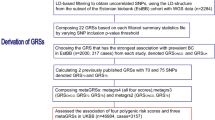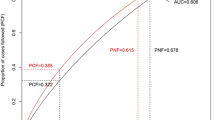Abstract
Recently identified susceptibility alleles from Genome-Wide Association Studies (GWAS) for breast cancer provide an option to stratify women for their breast-cancer risk based on these alleles. This may allow greater precision in targeting preventive efforts at genetically high-risk groups. Given the variation in allele frequencies between populations, the utility of such risk-stratification may vary in different populations. We examined the possibility for individualized disease risk stratification based on common breast cancer risk alleles, and its potential impact on population-based screening in a population of Asian women. We assigned allele frequencies based on available data from the Singapore Genome Variation project and tested the utility of 13 previously validated single nucleotide polymorphisms in predicting risk using simulation and originally reported relative risks. We also tested how these markers performed collectively in distinguishing risk groups and evaluated their possible use for individualized mammography screening. Our analysis suggests that the risk profile generated by 13 single nucleotide polymorphisms as identified through GWAS provides different risk profiles between ethnic groups (population genetic mean relative risk = 0.698, 0.617, 0.661, 0.743 for Caucasians, Singapore Chinese, Singaporean Malays, and Singaporean Indians, respectively) but that it does not provide sufficient discrimination to be useful in individualized prevention. Furthermore, these markers are not useful in risk stratification for population-based screening programs due to both cost and under-diagnosis of breast cancers in the general population. The clinical use of single, common, low-penetrance genes for breast cancer risk prediction in an Asian setting is currently limited.



Similar content being viewed by others
References
Garcia-Closas M, Hall P, Nevanlinna H, Pooley K, Morrison J, Richesson DA, Bojesen SE, Nordestgaard BG, Axelsson CK, Arias JI et al (2008) Heterogeneity of breast cancer associations with five susceptibility loci by clinical and pathological characteristics. PLoS Genet 4(4):e1000054
Ghoussaini M, Song H, Koessler T, Al Olama AA, Kote-Jarai Z, Driver KE, Pooley KA, Ramus SJ, Kjaer SK, Hogdall E et al (2008) Multiple loci with different cancer specificities within the 8q24 gene desert. J Natl Cancer Inst 100(13):962–966
Easton DF, Pooley KA, Dunning AM, Pharoah PD, Thompson D, Ballinger DG, Struewing JP, Morrison J, Field H, Luben R et al (2007) Genome-wide association study identifies novel breast cancer susceptibility loci. Nature 447(7148):1087–1093
Cox A, Dunning AM, Garcia-Closas M, Balasubramanian S, Reed MW, Pooley KA, Scollen S, Baynes C, Ponder BA, Chanock S et al (2007) A common coding variant in CASP8 is associated with breast cancer risk. Nat Genet 39(3):352–358
Pharoah PD, Antoniou A, Bobrow M, Zimmern RL, Easton DF, Ponder BA (2002) Polygenic susceptibility to breast cancer and implications for prevention. Nat Genet 31(1):33–36
Loman N, Johannsson O, Kristoffersson U, Olsson H, Borg A (2001) Family history of breast and ovarian cancers and BRCA1 and BRCA2 mutations in a population-based series of early-onset breast cancer. J Natl Cancer Inst 93(16):1215–1223
Teo YY, Sim X, Ong RT, Tan AK, Chen J, Tantoso E, Small KS, Ku CS, Lee EJ, Seielstad M et al (2009) Singapore Genome Variation Project: a haplotype map of three Southeast Asian populations. Genome Res 19(11):2154–2162
Frazer KA, Ballinger DG, Cox DR, Hinds DA, Stuve LL, Gibbs RA, Belmont JW, Boudreau A, Hardenbol P, Leal SM et al (2007) A second generation human haplotype map of over 3.1 million SNPs. Nature 449(7164):851–861
Wright S (1950) Genetical structure of populations. Nature 166(4215):247–249
Stacey SN, Manolescu A, Sulem P, Thorlacius S, Gudjonsson SA, Jonsson GF, Jakobsdottir M, Bergthorsson JT, Gudmundsson J, Aben KK et al (2008) Common variants on chromosome 5p12 confer susceptibility to estrogen receptor-positive breast cancer. Nat Genet 40(6):703–706
Pharoah PD, Antoniou AC, Easton DF, Ponder BA (2008) Polygenes, risk prediction, and targeted prevention of breast cancer. N Engl J Med 358(26):2796–2803
Ahmed S, Thomas G, Ghoussaini M, Healey CS, Humphreys MK, Platte R, Morrison J, Maranian M, Pooley KA, Luben R et al (2009) Newly discovered breast cancer susceptibility loci on 3p24 and 17q23.2. Nat Genet 41(5):585–590
Zheng W, Long J, Gao YT, Li C, Zheng Y, Xiang YB, Wen W, Levy S, Deming SL, Haines JL et al (2009) Genome-wide association study identifies a new breast cancer susceptibility locus at 6q25.1. Nat Genet 41(3):324–328
Thomas G, Jacobs KB, Kraft P, Yeager M, Wacholder S, Cox DG, Hankinson SE, Hutchinson A, Wang Z, Yu K et al (2009) A multistage genome-wide association study in breast cancer identifies two new risk alleles at 1p11.2 and 14q24.1 (RAD51L1). Nat Genet 41(5):579–584
Seow AKW, Chia KS, Shi LM, Lee HP, Shanmugaratnam K (2004) Trends in cancer incidence in Singapore 1998–2002, vol. Report No. 6, 2004, Singapore Cancer Registry, Singapore
Ministry of Health (2010) Cancer screening. MOH clinical practice guidelines 1/2010. Ministry of Health S. http://www.moh.gov.sg/mohcorp/uploadedFiles/Publications/Guidelines/Clinical_Practice_Guidelines
Lim GH, Wong CS, Chow KY, Bhalla V, Chia KS (2009) Trends in long-term cancer survival in Singapore: 1968–2002. Ann Acad Med Singap 38(2):99–105
Statistical Research and Applications Branch, National Cancer Institute (2005) Devcan: probability of developing or dying of cancer software version 6.4.1
Visscher PM, Hill WG, Wray NR (2008) Heritability in the genomics era—concepts and misconceptions. Nat Rev Genet 9(4):255–266
Acknowledgments
This research was supported by NMRC Center Grant, Singapore and Swedish Society for Medical Research.
Conflicts of interest
The authors declare no conflicts of interest.
Author information
Authors and Affiliations
Corresponding author
Electronic supplementary material
Below is the link to the electronic supplementary material.
Rights and permissions
About this article
Cite this article
Hartman, M., Suo, C., Lim, W.Y. et al. Ability to predict breast cancer in Asian women using a polygenic susceptibility model. Breast Cancer Res Treat 127, 805–812 (2011). https://doi.org/10.1007/s10549-010-1279-z
Received:
Accepted:
Published:
Issue Date:
DOI: https://doi.org/10.1007/s10549-010-1279-z




